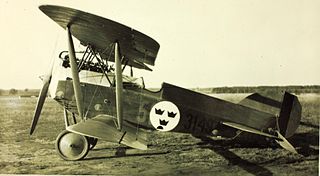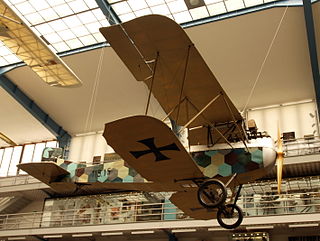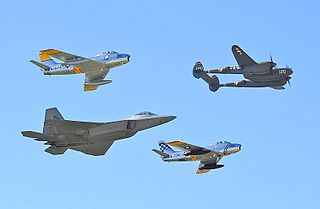
The Fokker D.I was a development of the D.II fighter. The D.I was also flown in Austro-Hungarian service as a reconnaissance aircraft under the designation B.III. Confusing the matter further, both the D.II and D.I arrived at the Front in German service at similar times, in July–August 1916. The main designer was Martin Kreutzer.

The Aviatik (Berg) D.I, was a single-engine, single-seater biplane fighter that was developed and manufactured by the Austro-Hungarian branch of German aircraft company Aviatik. It was also known as Berg D.I or the Berg Fighter, because it was designed by Dipl. Ing. Julius von Berg, and to distinguish it from the D.I fighter built by the parent Aviatik firm in Germany.

The Hansa-Brandenburg C.I, also known as Type LDD, was a 2-seater armed single-engine reconnaissance biplane designed by Ernst Heinkel, who worked at that time for the parent company in Germany. The C.I had similarities with the earlier B.I, including inward-sloping interplane bracing struts. Like other early-war Austro-Hungarian reconnaissance aircraft, such as C-types of Lloyd or Lohner, the Type LDD had a communal cockpit for its crew.

The Hansa-Brandenburg CC was a single-seat German fighter flying boat of World War I. It was used by both the Kaiserliche Marine and the Austro-Hungarian Navy.

The Hansa-Brandenburg D.I, also known as the KD was a German fighter aircraft of World War I. Despite poor handling characteristics it was put into service by Austria-Hungary, where some aircraft served until the end of the war.
The Aviatik (Berg) D.II, the prototypes of which were known as Aviatik 30.22 and Aviatik 30.38, was an Austro-Hungarian fighter plane prototype towards the end of the First World War.

The Phönix D.I, with the D.II and D.III variants, was an Austro-Hungarian First World War biplane fighter built by the Phönix Flugzeug-Werke and based on the Hansa-Brandenburg D.I.

The Knoller C.II was a reconnaissance aircraft built in Austria-Hungary during World War I for use by the Austro-Hungarian army. It was a conventional biplane design with staggered wings, and seated the pilot and observer in tandem in an open cockpit. Like Knoller's preceding C.I design, the upper wing was swept back, but not as far as it had been on the earlier aircraft. The structure was wooden throughout, with the wings skinned in fabric and the fuselage in plywood. The interplane struts were made of steel and arranged in a warren truss configuration.

The Lloyd C.II and its derivatives, the C.III and C.IV were reconnaissance aircraft produced in Austria-Hungary during the First World War. They were based on the Lloyd company's pre-war C.I design, and like it, were conventional biplanes with swept-back wings.
The Aviatik C.I, the prototypes of which were known as Aviatik 30.14, Aviatik 30.15 and Aviatik 30.16, was an Austro-Hungarian 2-seat reconnaissance aircraft produced from 1917.(Note: the is not part of the designation, but used to disambiguate from the German-built Aviatik aircraft with the same designation.)

The Phönix C.I, given serial numbers in the Phönix 121 range, was an Austro-Hungarian First World War reconnaissance and general-purpose Biplane built by Phönix and Lloyd.

The Lloyd 40.05 was a very unorthodox experimental fighter/reconnaissance biplane produced by Lloyd (Ungarische Lloyd Flugzeug und Motorenfabrik AG / Magyar Lloyd Repülőgép és motorgyár Részvény-Társaság) in the Austro-Hungarian Empire during the First World War.
The Oeffag G , sometimes known as the Oeffag Type G or Oeffag-Mickl G, was a three-engined reconnaissance flying boat built in Austria during the First World War and deployed by the Kaiserlich und Königlich Seefliegerkorps.

The Hansa-Brandenburg L.16, was an experimental triplane fighter that was designed in the Austro-Hungarian Empire during the First World War.

The UFAG C.I was a military reconnaissance aircraft produced in the Austro-Hungarian Empire during World War I, by the Ungarische Flugzeugfabrik Abteil Gesellschaft (UFAG). It was introduced in April 1918, and was widely used on the Italian Front in the final months of World War I.
The Halberstadt C.III was a German single-engined reconnaissance biplane of World War I, built by Halberstädter Flugzeugwerke.
The Halberstadt C.IX was a German single-engined reconnaissance biplane of World War I, built by Halberstädter Flugzeugwerke. It was derived from the Halberstadt C.V, with a more powerful supercharged 230 hp Hiero engine.
The Knoller D.I series 70 was a prototype fighter aircraft built in thee Austro-Hungarian Empire during World War I for use by the Kaiserliche und Königliche Luftfahrtruppen (KuKLFT).
The Phönix 20.24 was a prototype German fighter plane built in the last months of World War II.
The WKF 80.04 was a prototype Austro-Hungarian reconnaissance aircraft built in the final months of World War I.















